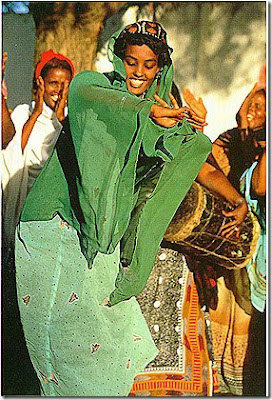Marriages can either be arranged or be as a result of a personal choice. Either way the groom's family elders set an appointment with the bride's family. In the nomadic society the groom's family brings a hundred camels, a horse and a gun to the bride's family as a dowry and in the urban the dowry is in the form of money. This is to respect the bride and her family and it reduced the meaningless divorce as it is not easy to let go with such a precious woman.
These cultural dances usually occur after a wedding. Weddings are perhaps one of the most important aspects of the Somali culture. A wedding denotes not only the union of two souls but the relationship between two families and, more importantly, two tribes.
Elders from the groom's family send a committee to the bride's family to request their daughter's hand for marriage. The bride's family elders welcome the committee from the groom's side. Mainly the discussions take place tentatively three days. The first day when the committee comes they present the motive of their visit.
On the second day, they discuss generally on the situation at hand. On the third day the engagement ceremony is prepared and the wedlock (engagement) takes place.
The engagement or Meher usually takes place a few days before the wedding, and sometimes on the same day. The wedding arrangements and agreements are all settled on that day to prepare for the big day. But before the jubilant groom can lay hands on his beautiful bride, there are many hurdles to cross and many gifts to bestow upon her family.
Traditional Somali Weddings have various ceremonies. On a Somali wedding day, many goats are slaughtered and plenty of a banquet of traditional food of rice, meat and drinks (juice or camel milk) are served for the men and women of the two families and their friends. This is when the formal Islamic wedding agreement takes place.
Different traditional as well as modern types of foods are usually served for the guests to enjoy as they carry on with the festivities. A further important tradition in Somali marriage is the exchanging of gifts. The exchange is normally done between the bride's family and groom's family and between the invited guests and the wedding couple.
The bride and bridesmaid are taken to the beauty salon. Nowadays, the bride usually wears a white wedding dress to her party. The other women wear DIRAC and can wear their hair loose or covered with a scarf.
In the afternoon celebrations take place both at the bride's family residence and her new home to be where bride and groom's family and friends attend. In the ceremony cakes, biscuits and other sweets plus iced drinks (fruit juice) are served. Traditional entertainments are played and blessing poems called BURAANBUR are recited.
In the evening the bride is escorted to her new home by her bridesmaid, family members and friends. The ceremony continues till late night, and sweets and iced drinks (soda and fruit juice) are served for the guests. The groom and his family are expected to pay for these celebrations.
It is a tradition in Somali culture that a new bride remains in her home for a week after her wedding. One of her bridesmaid or a family member stays with her for the seven days to help around the house and do the house chores.
On the third day of her wedding, relatives from the groom side visit the newly wedded couple. They bring drinks (no alcohol), cakes, different types of sweets, and other stuff.
On the seventh day there is a women's party for the bride. On this occasion the bride will wear traditional costume, GUNTIINO. The guests circle the bride singing and each lays a scarf (SHAASH) on her head. This event is known as SHAASH SAAR, basically IT means putting the scarf (SHAASH) on the bride's head. This is a form of respect due to her for being married and is a symbol of her becoming a married woman. The SHAASH is made of silky material and can have many patterns and colors, but it is totally different than the scarves worn by the unmarried women.




No comments:
Post a Comment